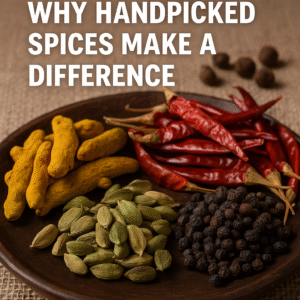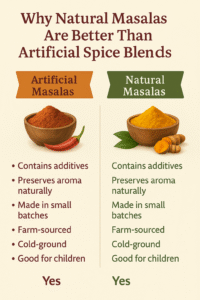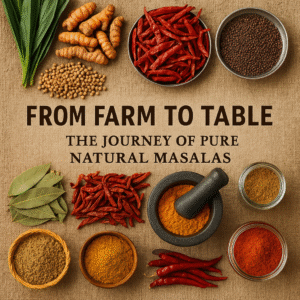Why Handpicked Spices Make a Difference
 In the heart of every flavorful dish lies a secret—spices. From the warm aroma of cinnamon in your morning chai to the bold heat of red chili in a curry, spices do more than just season food. They carry tradition, enhance taste, and even offer health benefits. But not all spices are created equal. The difference between average and extraordinary flavor often comes down to one thing: handpicked spices.
In the heart of every flavorful dish lies a secret—spices. From the warm aroma of cinnamon in your morning chai to the bold heat of red chili in a curry, spices do more than just season food. They carry tradition, enhance taste, and even offer health benefits. But not all spices are created equal. The difference between average and extraordinary flavor often comes down to one thing: handpicked spices.
In today’s fast-paced, industrialized food market, many spices are mass-produced and machine-processed. While this approach may increase quantity, it often sacrifices quality. Handpicked spices, on the other hand, are carefully selected, cleaned, and packed with purpose. This personal touch brings out the best in each spice—ensuring freshness, aroma, potency, and purity.
In this article, we’ll explore why handpicked spices truly make a difference—from farm to flavor.
—
1. The Art of Selection
Handpicking spices is an age-old tradition that reflects care and expertise. Farmers and workers who handpick spices don’t just gather any plant part—they know how to identify the perfect maturity, color, and aroma that indicate peak quality.
For example:
Turmeric is harvested when the rhizomes are firm, deep orange inside, and fully matured.
Cardamom pods are picked when they’re plump and green, not dry or yellow.
Chilies are selected based on their heat level and drying potential.
Machine-harvested spices often pick immature or overripe produce, which affects flavor and quality. Handpicking ensures that only the best parts of the crop make it into your kitchen.
—
2. Superior Flavor and Aroma
One of the first things you’ll notice about handpicked spices is their intense aroma. That’s because they’re not only picked at the right time, but also dried and stored correctly to retain essential oils and volatile compounds.
These essential oils are responsible for:
The sweetness of cinnamon
The heat of black pepper
The earthy tones of cumin
Handpicked spices are often sun-dried naturally, instead of being force-dried through industrial ovens. This slow drying process preserves their flavor and scent, which you’ll notice immediately when you open the container or roast them in oil.
Imagine the difference between store-bought, faded coriander powder and freshly ground coriander from hand-selected seeds. The aroma alone can transform a dish.
—
3. Purity and Cleanliness
When spices are handpicked, they undergo manual sorting and cleaning. Workers remove debris, stones, and inferior-quality pieces by sight and touch—something machines cannot do as precisely.
Mass-processed spices often contain:
Dirt
Pesticide residue
Moldy or broken parts
In contrast, handpicked spices are visually inspected and sorted with care. This attention to detail results in a cleaner, more reliable product—something health-conscious consumers deeply appreciate.
At NaturalMasala.com, for example, all our spices are hand-selected and thoroughly cleaned to ensure there are no impurities. What you get is a 100% pure, chemical-free spice with no added fillers.
—
4. Health Benefits of Unadulterated Spices
Handpicked spices are usually sourced from sustainable farms and are minimally processed, which means they retain more of their natural nutrients and medicinal properties.
Examples:
Handpicked turmeric contains higher levels of curcumin, a powerful anti-inflammatory compound.
Freshly selected black pepper has more piperine, which enhances nutrient absorption.
Cloves chosen at peak freshness are rich in antioxidants and essential oils.
Mass-market spices often undergo high-heat processing, polishing, or chemical treatment, which can destroy many of these natural benefits. That’s why handpicked spices are ideal for not just taste, but also Ayurvedic and medicinal use.
—
5. Support for Traditional Farming Communities
When you choose handpicked spices, you’re often supporting local farmers and workers who follow traditional methods passed down through generations. These communities rely on sustainable farming practices and hand-harvesting to earn a living.
Your purchase contributes to:
Fair wages
Skill preservation
Environmentally friendly agriculture
Many small spice farms in India, Sri Lanka, and Southeast Asia thrive because of the growing demand for quality, handpicked products. By buying from responsible brands that source directly from farmers, you’re helping keep these traditions alive.
—
6. Better Shelf Life
Handpicked spices usually last longer in your kitchen. Because they’re carefully selected and stored, they retain essential oils and moisture balance that help preserve their properties.
Tips for storage:
Store in airtight containers
Keep away from direct sunlight
Use whole spices and grind fresh for best results
Properly stored handpicked spices can retain peak flavor and aroma for 6–12 months longer than their mass-produced counterparts.
—
7. Visual Appeal and Texture
Quality isn’t just about taste—it’s also about how spices look and feel. Handpicked spices are often:
Uniform in size and color
Free from blemishes or mold
Full-bodied and aromatic
This matters more than you might think. A well-presented spice adds visual richness to food and enhances the sensory experience. For instance, whole cardamom pods that are green and firm indicate freshness and potency. Dull, faded ones are likely old and flavorless.
—
8. Traceability and Trust
When spices are sourced responsibly and handpicked, you often know exactly where they came from. Transparent brands provide information about:
The farm location
The harvest time
Drying and storage methods
This traceability builds trust between the brand and the consumer. You know you’re not getting a mix of leftovers or chemically treated powders, but a spice that’s been cared for at every step.
Many premium spice brands now include QR codes on their packaging, allowing you to trace the journey of your spice—from soil to spoon.
—
9. Eco-Friendly and Sustainable
Industrial spice farming often relies on:
Chemical fertilizers
Machine harvesting
Excess packaging
Handpicked spice operations are generally more eco-conscious. They avoid harsh chemicals, use traditional composting, and adopt low-waste drying and storage techniques. This not only protects soil health and biodiversity but also ensures a cleaner product for you.
By choosing handpicked spices, you’re making a sustainable lifestyle choice that benefits the planet and your body.
—
10. An Elevated Culinary Experience
Ultimately, handpicked spices elevate your cooking. Whether you’re making a simple dal, an elaborate biryani, or a wellness drink like turmeric latte, the depth of flavor from hand-selected ingredients is unmatched.
Professional chefs and home cooks alike agree: the key to extraordinary food isn’t just technique—it’s the quality of the ingredients.
—
Final Thoughts
Spices are more than flavor enhancers—they’re storytellers, medicine, and tradition wrapped in fragrance. When you choose handpicked spices, you’re choosing purity, flavor, and authenticity.
From better aroma and health benefits to supporting local farmers and protecting the environment, the advantages are too strong to ignore.
So next time you buy spices, look beyond the label. Ask:
Where did this spice come from?
Was it treated with care or just processed for profit?
Will it add true flavor or just a hint?
At NaturalMasala.com, we believe in offering only the finest handpicked spices—because we know quality begins at the source.







